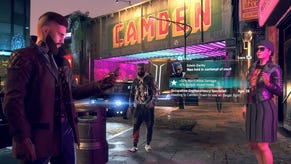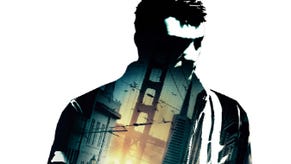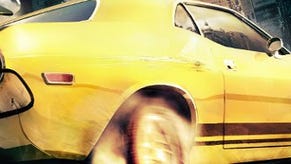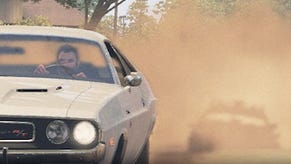Get your shift together - Driver multiplayer hands-on
In a little over a month’s time Ubisoft is hoping to restore the Driver brand to its former glory. VG247 spends time with the multiplayer and Martin Edmonson to see how it’s ticking over.
A few months ago we secured hands-on time with the single-player element of Driver: San Francsico and were introduced to the “shift” mechanic - a coma-dream facilitated superpower that counted The Matrix, Quantum Leap, and Google Earth amongst its inspirations.
At the time, we discussed its narrative application with game producer Marie-Jo Leroux and senior designer Jean-Sebastien Decant, who explained that, “Shift is a way of staying in the action by instantly taking control of any vehicle that you can see, without ever having to get out of the car,” and that “The story is built around the shift mechanic.”
That’s all good and well, but what neither of them really banged their drums about was how much more perfectly suited to multi-player this central feature is. Nor how it turns an otherwise inane game of ‘tag’ into a morish, exciting clang-fest in which a couple of button presses keep you at the centre of the explicit car-on-car action.
Tag, you’re it
And so, it came as something of a pleasant surprise to discover just how much pure and simple fun is to be had by mixing a playground game with high speed car chases. Indeed, by far the most popular mode experienced at Ubisoft’s recent press day was Tag, in which six players compete to reach one hundred points by being ‘it’ for as long as they can.
Whilst tagged any contact with another player, be it the daintiest of glancing blows or a full-on collision, transfers the tagged status and sees that player’s score begin to rise from where it left off the last time they were ‘it’. Locating the tagged player is a simple matter of activating shift, zooming to their position and then appropriating the nearest car with which to shunt them.
More sophisticated tactics reveal themselves providing you can ignore the compulsive desire to immediately flit from car to car like a champion Zebedee jumper. Take a few moments from the lofty vantage point that shift affords to plan ahead and you might try tracking your target’s route and shifting to a vehicle with which to head them off at the next junction, for example.
Other considerations concern the type of vehicle with which you grab the coveted tag marker, as doing so disables shift and locks you into your current vehicle. While it can be tempting to take control of the imposing bulk of a trailer-laden lorry for maximum head-on stopping power, you must think about what you’ll do that slow moving mass of metal once you’re ‘it’.
“Shift really comes alive in multi-player, doesn’t it?” I can only agree.
A quick getaway is desirable and, thanks to the damage modelling, acquiring point scoring status with too heavy-handed a collision will impede the performance of your current drive - something that those chasing you do not have to consider, as they’re able to shift at will to any other vehicle.
Our bouts of Tag last barely longer than six or seven minutes but, thanks to shift each bout is six or seven minutes in which everyone is involved, all of the time. Nobody that grasped the concept of shift is left lagging behind, frustratingly chasing an onscreen arrow and trying to track down their target.
At the end of every session, lips that had been pursed in concentration break into broad smiles as hands unfurl from tightly held controllers. As Martin Edmonson, creative director and overseer of the Driver franchise comments to me after a particularly closely contested round.
“Shift really comes alive in multiplayer, doesn’t it?”
I can only agree. But what other flavours of multi-player can we expect alongside the timesink that Tag is proven itself to be?
“There’s a total of eleven online modes and eight split-screen two-player modes,” Edmonson says. “The 11 online include the likes of capture the flag and base defence modes amongst others; modes that you wouldn’t traditionally associate with an online driving game and it’s the shift mechanic that’s allowed us to do that.
“It’s allowed for modes that you’d be more likely to find in a first-person shooter multi-player - that just wouldn’t really work without shift because if you crash and the rest of the guys are disappearing off into the sunset that’s not going to be much fun, right?”
There are more straight-laced, pure driving modes too because, as Edmonson is only too aware “We’re a driving game as well, so we want to make sure we offer that experience”, though whether any of these will match the out and out fun of those that feature shift remains to be seen.
Catch me if you can
The other mode that we see on the day is cops and robbers, in which one player who is unable to shift must reach four drop points on the map whilst the other players flit from car to car, turning each into a cop car in an effort to render the robber’s car immobile. It’s sinister: the way the cars around you shape-shift, flickering from harmless AI to the enemy in an effect similar to that of a civilian morphing into an agent in The Matrix films.
Edmonson confesses that they had intended to show other modes but that, with its short bursts of high action and easy to grasp nature, Tag is the mode everyone keeps coming back to. It should be noted that, in addition to its compulsive gameplay, the technical accomplishment of shift plays a significant role here. Whilst it’s fair to acknowledge that running a six-player session over a local network is at a lot less risk of experiencing lag or bandwidth issues, the seamlessness of shift’s multiple levels of zoom and the immediacy of its response is to be congratulated.
It may seem indulgent to wax lyrical about one, seemingly contrived, game feature but over the course of hands-on time with both the single and multi-player modes it’s proven itself to be every bit as key to the identity to Driver: San Francisco as the 200 miles of road, 120 licensed cars and the return Tanner.
The six-player demo pods remain some of the busiest of Ubisoft’s press day, perhaps simply because Driver: San Francisco’s multi-player is looking a lot more fun and entertaining than many might have expected – something that Ubisoft and Reflections should consider a major boon.
The game has been four years in development and Edmonson, especially, is ready for the world to see the fruits of his team’s labour.
“After four years in development we feel a bit like expectant mothers - we just really want to get it out there now.”
Driver: San Francisco launches for Mac, PC, PlayStation 3 and Xbox 360 on August 30 in the US and September 2 in PAL territories. A separate Wii version, with a different storyline and gameplay focus, is also is the works with more details due at a later date.









